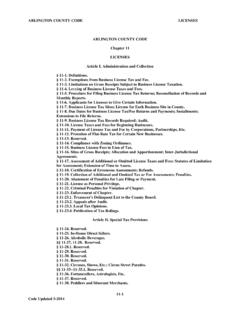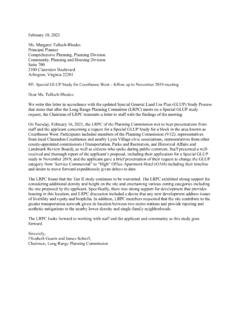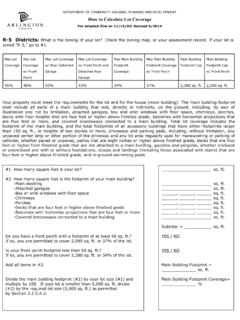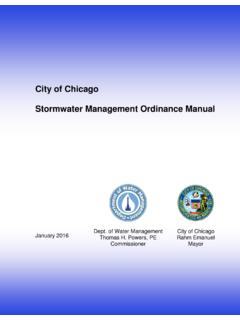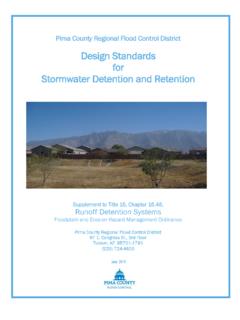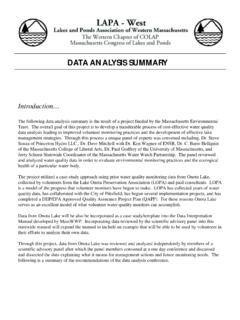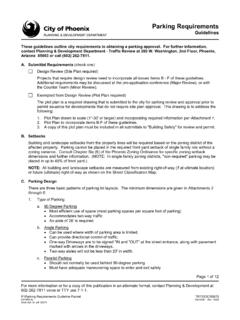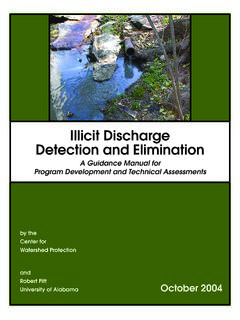Transcription of Stormwater Guidance Manual - Arlington County, Virginia
1 Stormwater Manual : A GUIDE TO Stormwater REQUIREMENTS FOR LAND DISTURBING ACTIVITIES IN Arlington county July 2021 i July 2021 1 Introduction .. 1 2 Stormwater Pollution Prevention Plan (SWPPP) Requirements .. 2 Erosion and Sediment (E&S) Control Plan .. 2 Stormwater management Plan (SWMP) .. 2 Contents of Plan .. 2 Water Quantity Technical Criteria .. 5 Water Quality Technical Pollution Prevention Plan (P2 Plan) ..33 Registration Statement Stormwater Facility Maintenance and Monitoring Agreement (MMA) ..34 Construction Operator Inspections ..34 Construction Record Drawing Requirements (As-built Certification) ..34 Enforcement ..34 Requirements for Single Family Residences Built Separately ..34 Additional performance requirements effective September 13, 2021 ..35 Alternative Compliance Option ..38 Streamlined Method ..41 Fee Schedule.
2 43 Bonds ..44 Post Construction Inspection and Maintenance 3 Landscape Conservation Plan Requirements ..45 Plan Requirements for Site Plan and Other Conditioned Projects ..46 Plan Requirements ..46 Landscape Conservation Plan ..46 Tree Protection Plan ..47 Tree Planting/Landscape Plan ..50 Details and Correspondence ..52 Requirements Before and During Construction ..52 Violations and Mitigation ..53 Exemptions ..53 4 Resource Protection Area Requirements ..54 Resource Protection Area ..54 Flow Chart for Resource Protection Area Compliance ..55 Subdivision Plats ..56 Plan Requirements for Projects Disturbing 2,500 square feet ..56 ii July 2021 RPA Delineation ..56 Water Quality Impact Assessments ..57 Exceptions ..59 What Activities in the RPA Require an Exception? ..59 Exception Requests Process ..60 RPA Mitigation and Buffer Enhancement Requirements.
3 60 Mitigation and Buffer Enhancement Guidance for single family home projects ..61 Re-vegetation and Buffer Enhancement Plan Elements ..62 Projects Disturbing Less Than 2,500 Square Feet in the RPA ..64 Mitigation and Buffer Enhancement ..65 Buffer Modification and Discrete Tree Removal ..65 Exempted Activities ..66 5 Floodplain Requirements ..66 Appendix A: Stormwater Facility Maintenance and Monitoring Agreement (MMA) Appendix B: SWPPP Template Appendix C: Water Quality Impact Assessment Data Sheet Appendix D: Exception Request Form Appendix E: 20-Yr Tree Canopy Coverage Worksheet Appendix F: Tree Protection and Planting Standards Appendix G: Construction Inspection Checklists and Certification Templates Abbreviations Chapter 57 Erosion and Sediment Control ordinance Chapter 60 Stormwater management ordinance Chapter 61- Chesapeake Bay Preservation ordinance CO Certificate of Occupancy DES Arlington county Department of Environmental Services Director - Director of the Department of Environmental Services or designee.
4 DEQ Virginia Department of Environmental Quality ISD Arlington county Inspection Services Division LDA Land Disturbing Activities Permit iii July 2021 MMA - Maintenance and Monitoring Agreement RPA Resource Protection Area SWMF Stormwater management Facility VRRM Virginia Runoff Reduction Method WQIA Water Quality Impact Assessment 1 July 2021 1 Introduction This Manual outlines the Stormwater requirements for all land disturbing activities in Arlington . A Land Disturbing Activity/ Stormwater (LDA) Permit is required for any land disturbing activities that disturb equal to or greater than 2,500 square feet of land, as required by the Erosion and Sediment Control ordinance (Chapter 57), Stormwater management ordinance (Chapter 60), and the Virginia Erosion and Sediment Control Program. Land disturbing activities within Resource Protection Areas (RPAs) regulated under Chesapeake Bay Preservation ordinance (Chapter 61) are also governed by this Manual .
5 The term Director in this Manual refers to the Director of the Department of Environmental Services (DES) or designee. The area of land disturbance includes cumulative land disturbance over two (2) years, which will be calculated for any project during this period that involves structures, paved areas, and/or retaining walls to track whether the cumulative threshold is exceeded. Projects with land disturbance of 2500 square feet or greater are subject to the requirements of Chapter 2 and 3 of this Manual . Any land disturbance in a Resource Protection Area (RPA) is subject to the requirements of Chapter 4 of this Manual . The following flowchart outlines the submission process for activities that will cause land disturbance. 2 July 2021 2 Stormwater Pollution Prevention Plan (SWPPP) Requirements Any activity that disturbs 2500 square feet or more of land requires a Stormwater Pollution Prevention Plan per the requirements of Arlington county Code Chapter 60.
6 This plan contains the fol lowing elements: Erosion and Sediment (E&S) Control Plan Stormwater management Plan (SWMP) Pollution Prevention Plan (P2 Plan) Virginia Stormwater management Program (VSMP) Requirements Stormwater Facility Maintenance and Monitoring Agreement (MMA) Erosion and Sediment (E&S) Control Plan An erosion and sediment control plan must be submitted that satisfies the requirements of Arlington county 's Erosion and Sediment Control ordinance (Chapter 57 of the county Code). Specifically, the E&S plan must: Minimize the construction footprint. Delineate the limits of clearing and grading, including details about how these limits will be physically marked in the field. Delineate the RPA boundary (see Chapter 4 of this Manual ), including details about how this boundary will be physically marked in the field. Include tree protection measures required under the approved Landscape Conservation Plan to ensure protection during clearing, grading, and all phases of construction.
7 Provide for a single ingress/egress point for construction activities, unless otherwise approved by the county Manager. Include a general note tailored to the site conditions that includes the language The county E&S inspector has the authority to require additional controls as needed. Stormwater management Plan (SWMP) The Stormwater management Plan (SWMP) contains the elements in Section in addition to the details of any Stormwater management facility (SWMF) used to meet the requirements of Sections and A Stormwater management facility (SWMF) is a control measure that manages Stormwater runoff and changes the characteristics of that runoff including, but not limited to, the quantity and quality, the period of release or the velocity of flow and may also be called a best management practice (BMP). Contents of Plan All Stormwater management Plans must be signed and sealed by a professional registered in the Commonwealth of Virginia and must include the following items: Contact information including the name, mailing address, email address, and telephone number of the owner and the RPC number and parcel number of the property or properties affected; A narrative that includes a description of current site conditions and final site conditions; A general description of the proposed Stormwater management facilities and the mechanism through which the facilities will be operated and maintained after construction is complete; A map or maps of the site that depicts the topography of the site and includes: 3 July 2021 o All contributing drainage areas including pre-development and post-development areas.
8 O Existing streams, ponds, culverts, ditches, wetlands, other water bodies, and floodplains; o Soil types, infiltration rates (using test procedures in Virginia Stormwater BMP Clearinghouse Appendix 8-A), and depth of water table at location of proposed SWMFs (if SWMF uses infiltration); o Forest cover, and other vegetative areas; o Current land use including existing structures (and downspouts), roads, and locations of known utilities and easements; o Sufficient information on adjoining parcels to assess the impacts of Stormwater from the site on these parcels; o The limits of clearing and grading, and the proposed drainage patterns on the site; o Proposed buildings (including downspouts), roads, parking areas, utilities, and Stormwater management facilities; Completed and executed copy of Stormwater Facility Monitoring and Maintenance Agreement (MMA); Hydrologic and hydraulic computations outlined in Section , including runoff characteristics; Runoff reduction computations outlined in Section Impervious cover Chapter 60 defines impervious cover as a surface composed of any material that significantly impedes or prevents natural infiltration of water into the soil.
9 Depending on the design, impervious surfaces may include, but are not limited to: roofs, buildings, streets, parking areas, and any concrete, asphalt, or compacted gravel or dirt surface. At a minimum, the following gravel and dirt surfaces are considered impervious: Any gravel or dirt surface used for the parking of vehicles. Any dirt surface under a deck. The following gravel surfaces are not considered impervious: Areas under a deck or similar structure designed for water to flow through the surface material with at least six (6) inches of gravel on the ground underneath and less than four (4) feet of clearance to prevent frequent use that causes compaction. Dry wells, level spreaders, and other drainage features required by the LDA permit. Impervious cover removal Impervious cover removed from a property prior to LDA permit application can be counted as part of the existing land cover conditions as follows: 1.
10 If no LDA or other demolition permit was obtained for the removal, the impervious cover removed may be counted for up to five (5) years from the date of removal if acceptable, time-referenced documentation is provided to the Director. Examples of acceptable documentation may include but are not limited to photographs (aerial and ground-based) and contractor invoices. 4 July 2021 The Director will determine whether the documentation verifies the timing and amount of removal and, if so, the credit provided will be the verifiable surface area of impervious cover removed. After five (5) years, the credit provided will be 50 percent of the verifiable surface area removed, with no credit provided after 10 years. 2. If an LDA or other demolition permit was obtained for the removal of the impervious cover, the surface area of impervious cover removal documented with the permit information may be counted as follows: All projects except county projects Time from date of removal permit issuance to date of LDA permit application Pro-rated impervious cover removal credit 0 - 5 years 100% credit >5 - 10 years 75% credit >10 - 15 years 50% credit >15 - 20 years 25% credit >20 years 0% credit county projects Because of the long planning, civic engagement, and funding timelines associated with county projects, including the 10-year planning horizon for the Capital Improvement Plan, full (100%) credit for impervious cover removal will be provided for 10 years from the date that permit(s) were issued for the impervious cover removal.

